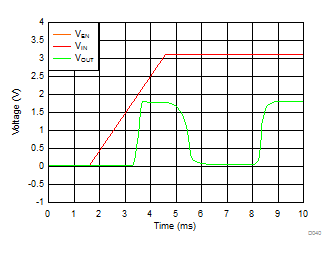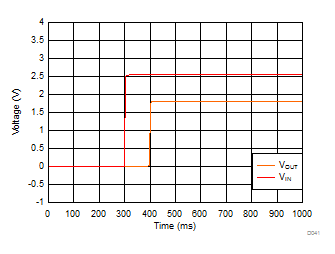JAJSEQ7D February 2018 – August 2019 TPS7A05
PRODUCTION DATA.
- 1 特長
- 2 アプリケーション
- 3 概要
- 4 改訂履歴
- 5 Pin Configuration and Functions
- 6 Specifications
- 7 Detailed Description
-
8 Application and Implementation
- 8.1 Application Information
- 8.2 Typical Application
- 9 Power Supply Recommendations
- 10Layout
- 11デバイスおよびドキュメントのサポート
- 12メカニカル、パッケージ、および注文情報
パッケージ・オプション
メカニカル・データ(パッケージ|ピン)
サーマルパッド・メカニカル・データ
- DQN|4
発注情報
8.1.3 Special Considerations When Ramping Down VIN and Enable
Care must be taken when ramping down voltage on the IN and EN pins to power-down the device when the operating free-air temperature is less than 15°C. The minimum ramp-down time for the IN pin is 10 ms. The minimum ramp-down time for the EN pin is 100 µs. Ramping at faster rates can cause the regulator to exhibit undesired startup behavior on the next power-on.
If VIN is ramped down faster than 10 ms, the next startup may exhibit a partial startup, shutoff, followed by a normal soft-start startup. Figure 48 shows this response.
 Figure 48. Partial Startup, Shutdown, Normal Startup With VEN = VIN
Figure 48. Partial Startup, Shutdown, Normal Startup With VEN = VIN If the EN pin is ramped down faster than 100 µs, the next startup may exhibit a delay time of up to 130 ms before the output ramps up with a normal soft-start startup. Figure 49 shows this delay.
 Figure 49. Long Delay to Startup With VEN = VIN
Figure 49. Long Delay to Startup With VEN = VIN Fast ramp downs of VIN and the EN pin charge internal high-impedance nodes in the device, which take extended time to discharge below 15°C. To avoid these startup behaviors, follow the recommended minimum ramp down times for VIN and the EN pin.